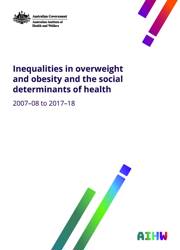Summary
Overweight and obesity is a major public health issue in Australia. It is associated with poorer health and wellbeing and an increased risk of chronic disease and associated health-care costs. In 2017–18, around 2 in 3 (67%) Australians aged 18 and over, and 1 in 4 (25%) children and adolescents aged 5–17, were overweight or obese.
Overweight and obesity can be influenced by individual factors—such as the type of food people eat and how much physical activity they do—as well as by other factors, including the environment and society in which they live. Social determinants of health—the circumstances in which people grow, live, work and age—can strengthen or undermine the health of individuals and communities. Therefore, social inequalities and disadvantage often contribute to unfair and avoidable differences in health outcomes across groups in society.
This report examines the associations between overweight and obesity and factors that include a person’s level of education, occupation, household income and household make‑up. It brings together data from 4 National Health Surveys (NHSs) held between 2007–08 and 2017–18 to examine how the prevalence of overweight and obesity has changed for children and adolescents aged 5–17, working age Australians aged 18–64 and older Australians aged 65 and over.
Overall, it finds that people with higher levels of education are less likely to be overweight or obese. Living in Major cities and in homes that are owned outright may also be associated with a reduced likelihood of overweight and obesity.
Overweight and obesity is associated with lower levels of educational attainment
Between 2007–08 and 2017–18, the age-standardised prevalence of overweight and obesity was consistently higher for Australians of working age who had not completed or attended secondary school (ranging from 65–69% across the 4 surveys) than for those who held a bachelor degree or higher qualification (51–58%).
Similarly, for children and adolescents aged 5–17, the prevalence of overweight and obesity was generally higher for those whose parent had not completed or attended secondary school (24% in 2007–08, 29% in both 2011–12 and 2017–18) than for those whose parent held a bachelor degree or higher qualification (16% in 2007–08, 17% in 2011–12 and 21% in 2017–18).
When controlling for other social determinants of health and for individual factors examined in this report, working age Australians who did not complete or attend secondary school were between 1.4 to 2.1 times as likely to be overweight or obese as those with a bachelor degree or higher qualification.
Home ownership may be associated with lower overweight and obesity
Between 2007–08 and 2017–18, the age-standardised prevalence of overweight and obesity was consistently higher for Australians of working age who lived in a home owned with a mortgage (ranging from 62–65% across the 4 surveys) than for those who lived in a home owned outright (55–61%).
When controlling for other social determinants of health and for individual factors examined in this report, working age Australians who lived in a home owned with a mortgage or being rented were around 1.2 times as likely to be overweight or obese as those who lived in a home owned outright.
Living in Major cities may be associated with lower overweight and obesity
Between 2007–08 and 2017–18, the age-standardised prevalence of overweight and obesity was consistently higher for Australians of working age who lived in Inner regional (ranging from 65–70% across the 4 surveys) and Outer regional and Remote areas (64–69%) than for those who lived in Major cities (57–63%).
When controlling for other social determinants of health and for individual factors examined in this report, working age Australians who lived in Inner regional areas were around 1.2 times as likely to be overweight or obese as those who lived in Major cities.
People in some occupations have higher rates of overweight and obesity but the strength of the association is unclear
Between 2007–08 and 2017–18, the age-standardised prevalence of overweight and obesity was consistently higher for Australians of working age whose occupation was classified as:
- labourers (ranging from 61–67% across the 4 surveys)
- machinery operators and drivers (71–79%)
- managers (65–68%)
- sales workers (60–68%)
- technicians and trades workers (64–72%)
than for those working in professional occupations (for example, health, education and business professionals) (55–58%).
When controlling for other social determinants of health and for individual factors examined in this report, there were no clear differences in the odds of overweight and obesity between occupation groups.
Where to from here?
This report identifies various social determinants and their associations with overweight and obesity. Social and health factors are complex and interconnected. Understanding them and how they underpin overweight and obesity can help policy makers and health providers develop more targeted strategies to reduce inequalities and improve health-related outcomes.
1. Introduction
- What is overweight and obesity?
- What causes overweight and obesity?
- Data sources used in this report
- Data considerations
- Structure of this report
2. Children and adolescents (5–17 years)
- Overweight and obesity
- Obesity
3. Australians of working age (18–64 years)
- Overweight and obesity
- Obesity
- Waist circumference risk
4. Older Australians (65 years and over)
- Overweight and obesity
- Obesity
- Waist circumference risk
5. Discussion
- Overweight and obesity is associated with lower levels of educational attainment
- Rates of overweight and obesity differ for some occupations but the strength of the association is unclear
- Rates of obesity differ between households with the highest and lowest incomes but the strength of the association is unclear
- Overweight and obesity may be associated with household tenure and remoteness area
- What are the limitations of the data?
Appendix A: Detailed methods
- Data sources
- Data quality
- Measures
- Statistical analyses
End matter: Acknowledgments, Abbreviations, Symbols, Glossary, References, List of tables, List of figures, Related publications



